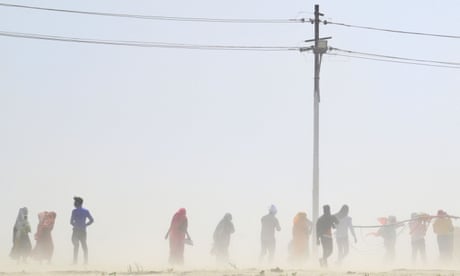Observations are enough to make scientists confident that the current period of warming is exceptional
By Scott Dance
July 8, 2023

Observations from both satellites and the Earth’s surface are indisputable — the planet has warmed rapidly over the past 44 years. As far back as 1850, data from weather stations all over the globe make clear the Earth’s average temperature has been rising.
In recent days, as the Earth has reached its highest average temperatures in recorded history, scientists have made a bolder claim: It may well be warmer than any time in the last 125,000 years.
Tracing climatic fluctuations back centuries and millennia is less simple and precise than checking records from satellites or thermometers. It involves poring through everything from ancient diaries to lake bed sediments to tree trunk rings.
But the observations are enough to make paleoclimatologists, who study the Earth’s climate history, confident that the current decade of warming is exceptional relative to any period since before the last ice age, about 125,000 years ago.
Our understanding of conditions so long ago is far less detailed than modern climate data, meaning it’s impossible to prove how hot it might have gotten on any given day so many thousands of years ago. Still, the Earth history gleaned from fossils and ice cores shows the recent heat would have been all but impossible over most of those millennia.
“There’s no way to drop one hot day into the middle of the ice age,” Richard Alley, a geosciences professor at Pennsylvania State University, said.

If climate records are like a cassette tape, the tape gets fuzzier and fuzzier the older they get, Peter Thorne, a professor at Maynooth University in Ireland, explained. But even the oldest tapes make a sound.
Records from the most recent decades are, of course, the most detailed. Data from the 1800s is slightly less rich, and slightly less precise, but still thorough. For a period going back about 2,000 years, scientists and historians have used artifacts and geologic observations to piece together climate patterns and extreme events on a scale from decades to single years.
Any earlier, data exists on scales averaged across decades to centuries. For example, a fossil of a fern found beneath a glacier tells scientists that conditions there were once much warmer. They can’t pinpoint the year the fern became trapped in sediment, but they can get a sense of how long ago climate patterns were such that a fern could grow in a given spot.
Measuring up a warm spell 6,000 years ago
If any a single day in the past 100,000 or 125,000 years could have been as hot as the Earth this week, scientists said it could only have occurred about 6,000 years ago. At that time, the planet had warmed with the end of the last ice age, and a period of global cooling began that would continue until the Industrial Revolution.
Scientists are confident that, apart from the global warming of recent decades, it was Earth’s warmest period in the past 100,000 years. They estimate that temperatures averaged somewhere between 0.2 degrees Celsius and 1 degree Celsius (0.36 to 1.8 degrees Fahrenheit) warmer than they were from 1850-1900.
In comparison, during a record-warm June last month, global temperatures averaged 1.36 degrees Celsius (2.4 degrees Fahrenheit) warmer than 1850-1900, according to Europe’s Copernicus Climate Change Service.
During the stretch 6,000 years ago, the warmth was largely the result of fluctuations in Earth’s orbit, which is elliptical rather than circular. While nowadays Earth gets closest to the sun in early January each year, at that time it happened around this time of year, during the Northern Hemisphere summer. That had an overall planetary warming effect because the Northern Hemisphere contains more land than the Southern Hemisphere, and land heats up quicker than oceans.
It’s possible that, even though average temperatures were probably similar to current conditions, day-to-day extremes could have been greater because the planet was so much closer to the sun during the Northern Hemisphere summer, Thorne said. That makes some paleoclimatologists reluctant to say for sure that this week produced the hottest single days in more than 100,000 years.
That conclusion is “certainly plausible,” said Michael Mann, a professor at the University of Pennsylvania known as a pioneer in studying historical climate data. But technically, without 120,000 years of daily temperature data, it becomes “a plausibility argument, rather than a definitive statement,” Mann wrote in an email.
Unlike any previous warm period, this one was caused by people
That is not to say the current heat isn’t extreme.
“I’m pretty damn certain it’s the warmest day in the last 2,023 years,” said Thorne, who was a coordinating lead author of a chapter exploring long-term changes to Earth’s climate in the Intergovernmental Panel on Climate Change’s Sixth Assessment.
That assessment states with “medium confidence” that temperatures from 2011-2020 exceed those of any multi-century period of warmth over the past 125,000 years.
Further, there is no evidence anywhere in scientists’ understanding of Earth’s history of warming that occurred nearly as rapidly as the ongoing spike in temperatures, caused by the burning of fossil fuels and emissions of greenhouse gases.
If a hotter day happened on Earth anytime in the past, Alley said, it was the result of natural processes.
“The current rise is not natural, but caused by us,” he said.





